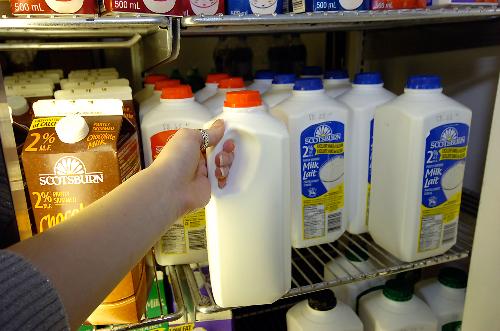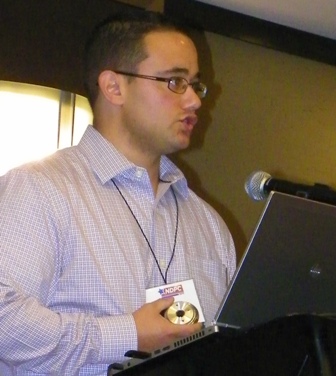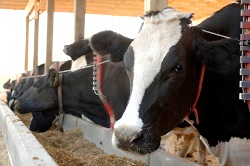 State Delegates Fail to Adopt Recommendations to Improve Milk Quality, Promote Truth-In-Labeling
State Delegates Fail to Adopt Recommendations to Improve Milk Quality, Promote Truth-In-Labeling
INDIANAPOLIS, IN – For the second time in two years, state public health and agriculture department officials participating in the National Conference on Interstate Milk Shipments (NCIMS) turned down a proposal to reduce the maximum allowable level of somatic cell counts in milk. A lower level of somatic cells indicates higher quality milk.
At its meeting in Indianapolis this week, the NCIMS voting delegates – a group of state regulators overseeing milk safety rules – considered a proposal sponsored by the National Milk Producers Federation (NMPF) to reduce the maximum threshold of allowable somatic cells in milk at the farm level from the current 750,000 cells/mL, down to 400,000, starting in 2015. But on a close vote, the delegates rejected the proposal, meaning that the status quo threshold of 750,000 will remain for domestic milk production – putting the U.S. “behind the curve when it comes to milk quality standards,” according to Jerry Kozak, NMPF President & CEO.
On a related decision with trade policy implications, the NCIMS delegates approved a proposal to permanently allow foreign dairy marketers to participate in the U.S. Grade A program, by permitting required sanitation evaluations of overseas dairy farms and processing facilities to be carried out by third-party, non-governmental inspectors.
“Dairy farmers in the world’s major milk producing regions have made great strides in reducing somatic cell count levels. Regulatory systems around the world have moved to incorporate these lower somatic cell count levels, and the U.S. needs to be on board with that process, not be left watching from the side of the road by the failure to update our standards,” said Kozak. “We continue to be perplexed by the inconsistency of those state regulators who voted to make it easier to import Grade A dairy products into the United States by outsourcing mandatory inspections, while at the same time rejecting efforts to facilitate the export of American dairy products,” Kozak said.
A similar somatic cell count proposal was defeated by the NCIMS in 2011. Since then, the European Union has moved ahead with a somatic cell count limit of 400,000 for dairy products being exported by the U.S. to EU member countries.
“While the NCIMS has performed admirably in protecting the safety of Grade A milk and dairy products for more than 60 years, we are now in a global dairy marketplace and the Conference needs to recognize this reality,” said Kozak.
“Our farmers are doing their part by continuing to provide ever-higher quality milk, but they are not getting credit for it with overseas customers because we are at the mercy of a regulatory mechanism that seems unwilling to maintain the same pace of improvement. Unfortunately, NCIMS is currently the only national regulatory forum at which to resolve these important issues for the dairy industry,” he said.
NMPF also expressed disappointment at the NCIMS delegates’ rejection this week of a resolution calling for the enhanced enforcement of federal labeling regulations affecting the marketing of imitation Grade A dairy products, such as soy, hemp and rice “milks,” and soy and rice “yogurt.” The recommendation was also opposed by representatives of the dairy processing community.
“Without the backing of state and federal regulators, and the dairy processing community itself, the nation’s dairy farmers remain the sole advocates for enforcement of proper labeling on imitation dairy products. It is disappointing that the leadership of the dairy processing industry spoke out against the labeling enforcement resolution,” Kozak added.
The National Milk Producers Federation, based in Arlington, VA, develops and carries out policies that advance the well-being of dairy producers and the cooperatives they own. The members of NMPF’s 30 cooperatives produce the majority of the U.S. milk supply, making NMPF the voice of more than 32,000 dairy producers on Capitol Hill and with government agencies.

 ARLINGTON, VA – A
ARLINGTON, VA – A  From Jerry Kozak, President and CEO, NMPF:
From Jerry Kozak, President and CEO, NMPF: The U.S. Dairy Export Council (USDEC) and National Milk Producers Federation (NMPF) applaud the United States’ decision to welcome Japan into Trans-Pacific Partnership (TPP) free trade negotiations.
The U.S. Dairy Export Council (USDEC) and National Milk Producers Federation (NMPF) applaud the United States’ decision to welcome Japan into Trans-Pacific Partnership (TPP) free trade negotiations. Prospects for Passing New Farm Bill Reviewed at National Dairy Producers Conference
Prospects for Passing New Farm Bill Reviewed at National Dairy Producers Conference Last month, NMPF joined the Center for Food Integrity and the U.S. pork sector to jointly launch "
Last month, NMPF joined the Center for Food Integrity and the U.S. pork sector to jointly launch "



